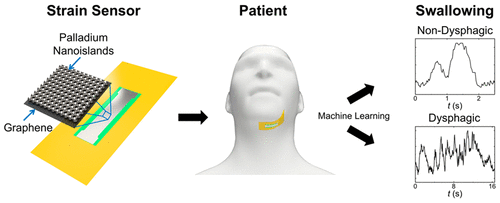Our official English website, www.x-mol.net, welcomes your feedback! (Note: you will need to create a separate account there.)
Metallic Nanoislands on Graphene for Monitoring Swallowing Activity in Head and Neck Cancer Patients
ACS Nano ( IF 17.1 ) Pub Date : 2018-06-06 00:00:00 , DOI: 10.1021/acsnano.8b02133 Julian Ramírez 1 , Daniel Rodriquez 1 , Fang Qiao 2 , Julian Warchall 3 , Jasmine Rye 1 , Eden Aklile 1 , Andrew S.-C. Chiang 1 , Brandon C. Marin 1 , Patrick P. Mercier 3 , C. K. Cheng 2 , Katherine A. Hutcheson 4 , Eileen H. Shinn 5 , Darren J. Lipomi 1
ACS Nano ( IF 17.1 ) Pub Date : 2018-06-06 00:00:00 , DOI: 10.1021/acsnano.8b02133 Julian Ramírez 1 , Daniel Rodriquez 1 , Fang Qiao 2 , Julian Warchall 3 , Jasmine Rye 1 , Eden Aklile 1 , Andrew S.-C. Chiang 1 , Brandon C. Marin 1 , Patrick P. Mercier 3 , C. K. Cheng 2 , Katherine A. Hutcheson 4 , Eileen H. Shinn 5 , Darren J. Lipomi 1
Affiliation

|
There is a need to monitor patients with cancer of the head and neck postradiation therapy, as diminished swallowing activity can result in disuse atrophy and fibrosis of the swallowing muscles. This paper describes a flexible strain sensor comprising palladium nanoislands on single-layer graphene. These piezoresistive sensors were tested on 14 disease-free head and neck cancer patients with various levels of swallowing function: from nondysphagic to severely dysphagic. The patch-like devices detected differences in (1) the consistencies of food boluses when swallowed and (2) dysphagic and nondysphagic swallows. When surface electromyography (sEMG) is obtained simultaneously with strain data, it is also possible to differentiate swallowing vs nonswallowing events. The plots of resistance vs time are correlated to specific events recorded by video X-ray fluoroscopy. Finally, we developed a machine-learning algorithm to automate the identification of bolus type being swallowed by a healthy subject (86.4%. accuracy). The algorithm was also able to discriminate between swallows of the same bolus from either the healthy subject or a dysphagic patient (94.7% accuracy). Taken together, these results may lead to noninvasive and home-based systems for monitoring of swallowing function and improved quality of life.
中文翻译:

石墨烯上的金属纳米岛可监测头颈部癌症患者的吞咽活性
有必要对头颈部放疗后癌症患者进行监测,因为吞咽活动减少会导致吞咽肌肉萎缩和纤维化。本文介绍了一种在单层石墨烯上包含钯纳米岛的柔性应变传感器。这些压阻传感器在14位无病的头颈癌患者中进行了测试,这些患者具有各种吞咽功能:从吞咽困难到严重吞咽困难。贴片状装置检测到(1)吞咽时食物团的稠度以及(2)吞咽困难和吞咽困难的差异。当与应变数据同时获得表面肌电图(sEMG)时,也可以区分吞咽与非吞咽事件。电阻vs时间与视频X射线荧光透视记录的特定事件相关。最后,我们开发了一种机器学习算法,可以自动识别健康受试者吞咽的大丸剂类型(准确度为86.4%)。该算法还能够区分来自健康受试者或吞咽困难患者的相同推注吞咽(准确度为94.7%)。综上所述,这些结果可能会导致用于监测吞咽功能和改善生活质量的非侵入性和家庭式系统。
更新日期:2018-06-06
中文翻译:

石墨烯上的金属纳米岛可监测头颈部癌症患者的吞咽活性
有必要对头颈部放疗后癌症患者进行监测,因为吞咽活动减少会导致吞咽肌肉萎缩和纤维化。本文介绍了一种在单层石墨烯上包含钯纳米岛的柔性应变传感器。这些压阻传感器在14位无病的头颈癌患者中进行了测试,这些患者具有各种吞咽功能:从吞咽困难到严重吞咽困难。贴片状装置检测到(1)吞咽时食物团的稠度以及(2)吞咽困难和吞咽困难的差异。当与应变数据同时获得表面肌电图(sEMG)时,也可以区分吞咽与非吞咽事件。电阻vs时间与视频X射线荧光透视记录的特定事件相关。最后,我们开发了一种机器学习算法,可以自动识别健康受试者吞咽的大丸剂类型(准确度为86.4%)。该算法还能够区分来自健康受试者或吞咽困难患者的相同推注吞咽(准确度为94.7%)。综上所述,这些结果可能会导致用于监测吞咽功能和改善生活质量的非侵入性和家庭式系统。



























 京公网安备 11010802027423号
京公网安备 11010802027423号